
Osiris (Asir) was the first son of Geb and Nut and the brother of Set, Horus (the elder), Isis, and Nephthys. He was one of the most prominent gods of the Heliopolitan Ennead, but his worship pre-dated the development of this fairly complex philosophy. Although Atum was installed as the head of the Ennead by the priests of Heliopolis, Osiris was considered to be the king of the underworld, and is the only deity who is referred to simply as “god”. This gives us some indication of his prominence and popularity.
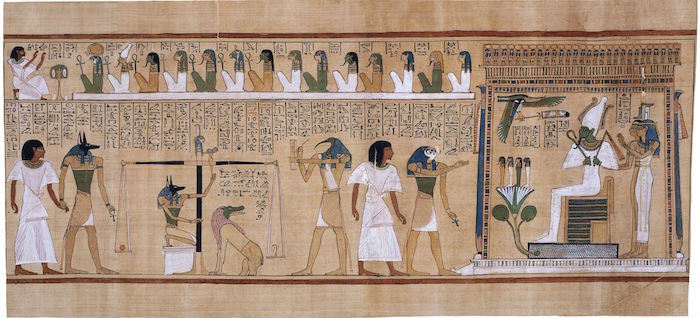
The oldest religious texts known to us refer to him as the great god of the dead, who once possessed human form and lived upon earth. After his murder by Set, Osiris became the king of the underworld and presided over the judgment of dead souls.
In order to enter his kingdom, the deceased had to undertake a perilous journey (aided by spells and amulets) to the hall of judgment where their heart was balanced against the feather of Ma’at (justice or balance).
It is important to distinguish this from the Christian view of judgment. The ancient Egyptians were a pragmatic people. A person was not expected to be perfect, just balanced. An example of this is the “negative confession” (in which the deceased listed all of the evil things he had not done during his lifetime, i.e. “I never murdered anyone”) which indicates that it was more a case of convincing Osiris that you deserved admission rather than passively awaiting judgment.
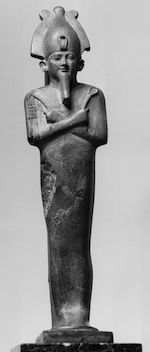
As Osiris had been a good and beneficent ruler during his lifetime, his presence in the underworld no doubt gave the people great comfort. Furthermore, the only barriers to entrance were those relating to the journey to the hall of judgment and the preservation of the body (in which the Ba resided) and your name. The spells needed to pass through Duat (the underworld) were described in great detail in the pyramid and coffin texts, “the book of coming forth by day” (also known as “the book of the dead”) and the “book of gates“. A decent burial combined with these spells pretty much guaranteed you would be welcomed into a blissful existence which bore a striking similarity to the ancient Egyptian’s everyday life (shorn of any problems).
Osiris was also a god of agriculture. This may seem rather strange as he was dead, and technically infertile. However, it actually makes a lot of sense when you consider the death and rebirth inherent in the agricultural cycle of planting and harvesting grain. Every harvest, the god was symbolically killed and his body broken on the threshing room floor, but after the inundation life would return to the land and the crops would grow again.
Legend held that the ancient Egyptians had been cannibals until Osiris developed agriculture and he and Isis persuaded them to cease that unpleasant habit. There is no evidence that the ancient peoples were in fact cannibals, but the myth underlined the notion that Osiris brought order from chaos and established the culture which formed the basis of their successful and durable civilisation.
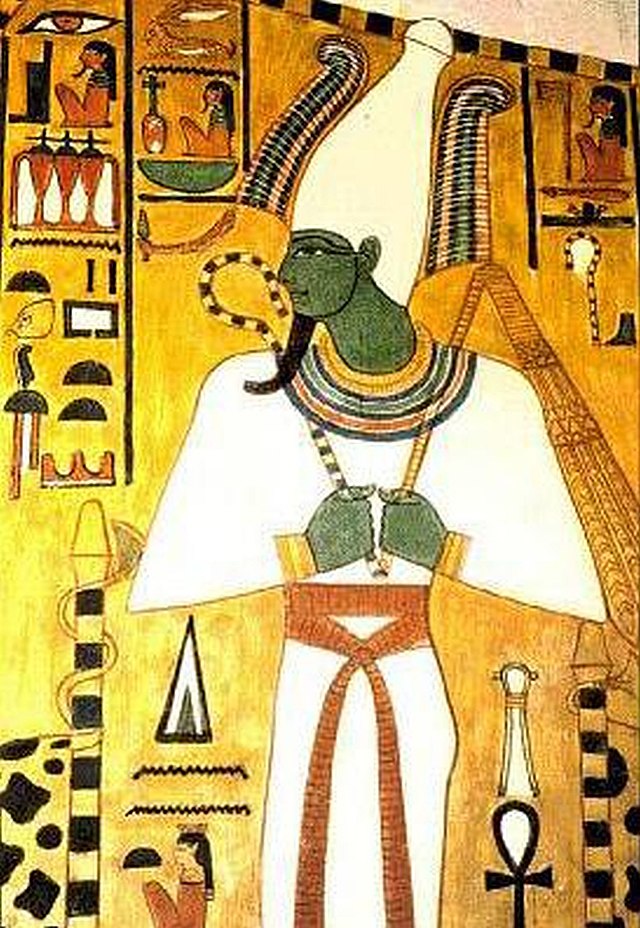
Osiris was usually depicted as a mummified king, complete with the ceremonial (curved) beard, crown, flail, and crozier. His skin is generally green or black, to represent the fact that he is dead. He usually wears the white crown of Upper Egypt (the south) or the Atef crown (the white crown with a plume of feathers on each side and a disc at the top). The feathers on the Atef crown are thought to represent Djedu (Busiris), the cult center of Osiris.
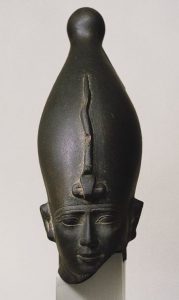
His kind smile confirms that he is not a deity to be feared. In fact, Osiris represented the Egyptian belief in rebirth and their feeling that order and justice persevered beyond the grave.
“Corn mummies” made of seeded dirt were molded to represent Osiris and interred with the deceased. They would germinate in the darkness of the tomb and illustrate the concept of life from death. Some fine examples made of barley and emmer were found in Tutankhamen’s tomb.
During the fourth month of the season of Akhet (emergence) a number of festivals were celebrated at all the chief sanctuaries of Osiris in Egypt, to commemorate the events of Osiris’ life, death, and rebirth. Spectators took part in the “passion plays” and everyone seems to have had a great time. The many festivals are recorded on a stele established by Ikhernofret (a prince who acted as Senusert III’s chief treasurer).
The myth of Osiris and Isis
Set had been jealous of his brother Osiris’ power and popularity for some time, and he lusted after his brother’s wife, Isis (Aset). When Osiris decided to travel the world to bring civilisation to its people, he made Isis Regent of Egypt instead of Set. This was the last straw. Set was strong and brave (he was not two-dimensionally “evil”) but he had a terrible temper and he vowed to kill his brother and take the power he considered to be rightfully his.

Set invited Osiris to a banquet and had a beautiful cedar wood and ebony chest made just for the occasion. He offered the chest to anyone who could fit into it. Just as Set planned, none of the other guests fitted the chest perfectly, the only person left to try was Osiris. When he lay down in the chest (which had been made to fit him), Set slammed on the lid and nailed it down. He sealed it with molten led and threw it in the Nile.
The chest was swept out to sea and landed on the coast near Byblos. The instant it touched the land, a huge Tamarisk tree sprouted up to protect it. The tree grew so large that the king of Byblos trimmed it and set it up as a pillar in his palace.
Isis tracked the body of Osiris to Byblos and persuaded the king to give it to her (by saving a child from a snake bite – easy for the “queen of heaven”). She took her husband’s corpse back to Egypt and used magic to conceive his child, Horus (other accounts suggest she was already pregnant when he died). However, Set found Osiris’s body unattended while Isis took the infant Horus to be cared for by Wadjet (or Udjat, “she who is green”, the cobra goddess of Lower Egypt).
Set cut the corpse of Osiris into fourteen (or sixteen) parts and distributed them around Egypt. Isis was distraught, and enlisted the help of her sister (and Set’s wife) Nephthys. They found all but one of the pieces. The missing part was his penis (poor guy) which was apparently swallowed by a fish sacred to Set.
Isis and Nephthys mourned over the dead body of their brother and Ra took pity on them. He sent Anubis to prepare Osiris for the first ever mummification, and instructed Thoth, Isis, and Nephthys to piece the body back together.
Isis transformed into a kite (common small bird) and breathed life into him, but it was not sufficient for him to take his place with the living. Instead he travelled to the underworld, a seemingly dark and desolate place. But Re reassured him that he would find peace and contentment as the king of the dead, and his son Horus would rule over the living until the time that Re chose to unmake his creation and return everything to the nothingness from whence it came.
Osiris and Anubis
Later, when the theology of Heliopolis (the Ennead) and Hermopolis (the Ogdoad) were merged, Osiris took over the role of Anubis as the god of the underworld (although he remained central to funerary rights). It was believed that Anubis had given way to Osiris out of respect, and a myth developed that Anubis was in fact the son of Osiris by Nephyths (his sister and wife of his brother Set).
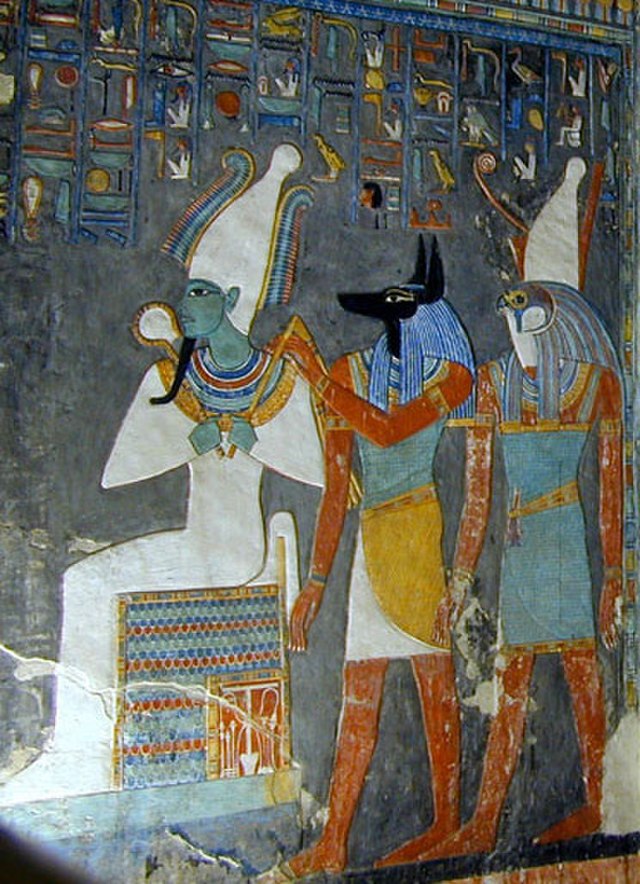
Nephthys was not happy with Set (who was described as being ugly) and so she sneakily disguised herself as her sister Isis and slept with Osiris. Nephythys was considered to be barren, but despite this she conceived Anubis. Surprisingly, Isis does not seem to get annoyed at either party, but unsurprisingly Set was furious. Thus, the myth provided a more personal reason for his vendetta against Osiris.
The myth is also thought to relate to one of the desert flowers common in ancient Egypt which did not bloom for years on end. However, a large inundation would bring it to life. Thus the barren desert (in this case Nepthys) became fertile, and Osiris’ connection with the life-giving Nile is strengthened.
Horus the elder and Horus the child
There are many separate hawk deities called Horus who are often confused. In the theology of Heliopolis, Horus the child was the child of Isis and Osiris. However, in Hermopolis Horus the elder was the son or husband of Hathor (her name is Hwt-Hor, or “the house of Horus”).
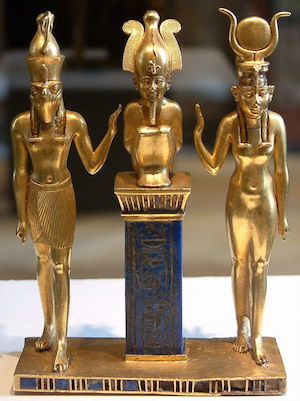
When the two theologies merged, Hathor and Isis became closely associated (both sometimes appear wearing a sun disk and bovine horns) and Horus the elder became the brother of Osiris and Set (making him the uncle of Horus son of Isis and Osiris). Thus Horus could be a solar deity (Horus the Elder or Haroeris) or an Osirian and hence stellar deity (often called Horus the child, Harpokrates or Harsiesis, horus son of Isis).
This confused the hell out of Plutarch (the Greek writer), who made up the story that Horus the elder was conceived by Isis and Osiris while they were in Nut’s womb! The pyramid texts confirm their separate identities as Horus the Elder warns the other gods not to get involved with Horus the younger and his “evil things” (unfortunately no details of these “things” are given).
Set was also the enemy of Horus the Elder, and some Egyptologists suggest that the battle for control of Egypt was actually played out between those two deities, with Osiris being inserted at a later time.
The many names and forms of Osiris
Osiris is the Greek form of his name. He was known to the Egyptians as Asir (sometimes transliterated as Wsir or Asar). The earliest form of his name used hieroglyphs for “throne” and “eye” leading some to infer that his name means “he sees the throne”. It is also possible that the second hieroglyph refers to the great “eye of heaven”, Ra. The throne or seat, is the first sign in the name of Aset (Isis), who is the female counterpart (wife and sister) of Osiris.
In the late period, Osiris was known as Un-nefer, from “un” (to open, to appear, to make manifest) and “neferu” (good things or beauty). He had too many epithets to mention, party because he adopted many of those originally possessed by other local gods whose attributes he assumed over time.
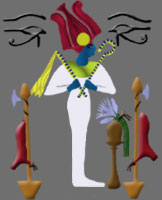
In Memphis, Ptah-Sokar was the result of the combination of Ptah (the creator god of Memphis) and Sokar (or Seker), a local falcon god who protected tombs and was the patron of the workers who built them). As a god of re-incarnation, Ptah-Sokar became identified with Osiris, becoming Ptah-Sokar-Asir. This deity represented the sun during its journey through the underworld before it was reborn at dawn.
Osiris also managed to absorb many other deities, making his worship (in one form or another) a constant feature all over Egypt. He was most closely associated with Andjety, Sahu, Khentiamentiu, Sepa, Banebdjed, Wepwawet, Serapis, and Anhur in his form as Ari-hes-nefer (also given as Arensnuphis, Arsnuphis, Harensnuphis) and both the Apis and Buchis bulls.
Bibliography
- Bard, Kathryn (2008) An introduction to the Archaeology of Ancient Egypt
- Goodenough, Simon (1997) Egyptian Mythology
- Grajetzki, W (2003) Burial Customs in Ancient Egypt
- Kemp, Barry J (1991) Ancient Egypt: Anatomy of a Civilisation
- Redford Donald B (2002) Ancient Gods Speak
- Watterson, Barbara (1996) Gods of Ancient Egypt
- Wilkinson, Richard H. (2003) The Complete Gods and Goddesses of Ancient Egypt
- Wilkinson, Richard H. (2000) The Complete Temples of Ancient Egypt
Copyright J Hill 2008